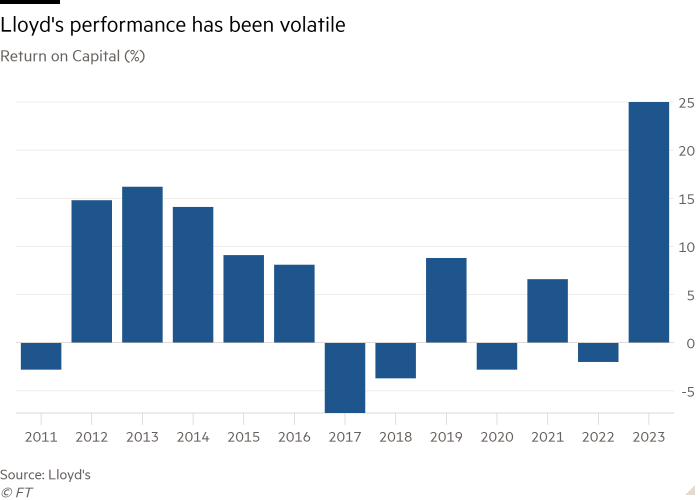Unlock the Editor’s Digest for free
Roula Khalaf, Editor of the FT, selects her favourite stories in this weekly newsletter.
Time-honoured institutions often struggle to adapt. Lloyd’s of London — the world’s oldest insurance market — acquired a reputation for inefficiency, complacency and boorish behaviour. Yet last year’s performance was the best for 16 years. Is Lloyd’s getting its mojo back?
The specialist market’s 2023 combined ratio — a measure of claims and expenses as a proportion of premiums — was an impressive 84 per cent, a 7.9 percentage point improvement. Costs remain high relative to its corporate peers. But it is digitising and simplifying claims handling. The expense ratio — 34.4 per cent last year — is likely to fall by two percentage points over the next few years, says S&P. The rating agency recently upgraded its credit rating on an improved underwriting performance and a stronger balance sheet.
Lloyd’s has also made progress in reviving face-to-face trading. The work-from-home trend made for a listless atmosphere at its City headquarters. Now numbers are back to nearly four-fifths of pre-pandemic levels, Tuesdays and Thursdays. The culture still needs improvement. But it met its short-term goal of filling 35 per cent of leadership roles with women.
UK insurer Aviva’s return to Lloyd’s after a two-decade absence is a vote of confidence. This month’s £242mn purchase of the Probitas syndicate will allow it to tap into what it said were the many brokers that prefer to place business via the Lloyd’s market. Mitsui Sumitomo Insurance also recently announced expansion plans for its Lloyd’s insurer.
But there is a fragility to this recent success. Last year’s results benefited from fewer hurricane claims as well as a steep rise in reinsurance prices. That is unlikely to continue, though Lloyd’s expects rates to level out rather than fall.
One year’s strong performance does not make up for dismal returns. The market’s return on capital was just 3.6 per cent since 2017, even taking account of last year’s 25 per cent return. That makes Lloyd’s attempt to open itself up to outside investors more challenging.

Supportive regulators help explain the success of rival centres such as Bermuda. MPs last year blamed regulatory foot-dragging for London losing out on $700mn of insurance-linked securities that went to Singapore.
Now the UK industry is lobbying for a light-touch regulatory regime to attract captive insurers. This is a test of the government’s commitment to support financial services. Lloyd’s may not get the attention its near-quarter share of City GDP deserves. If it is to keep up with rival global centres, it is not just the members who have their work cut out.
Lex is the FT’s flagship daily investment column. If you are a subscriber and would like to receive alerts when Lex articles are published, just click the button “Add to myFT”, which appears at the top of this page above the headline









